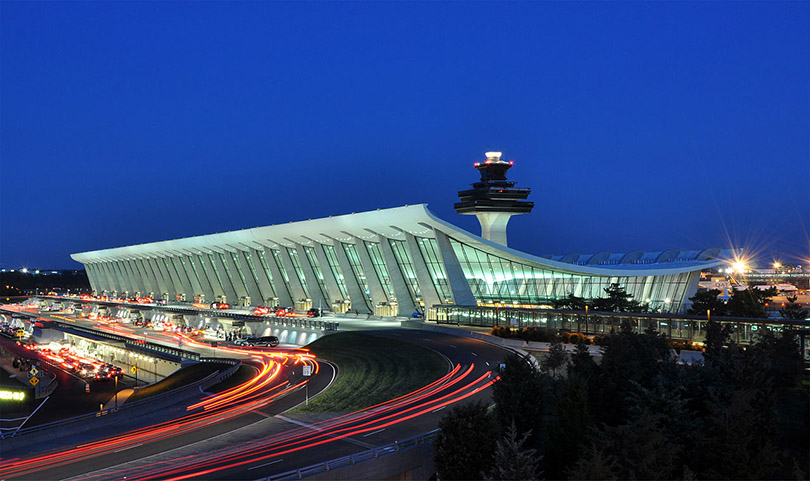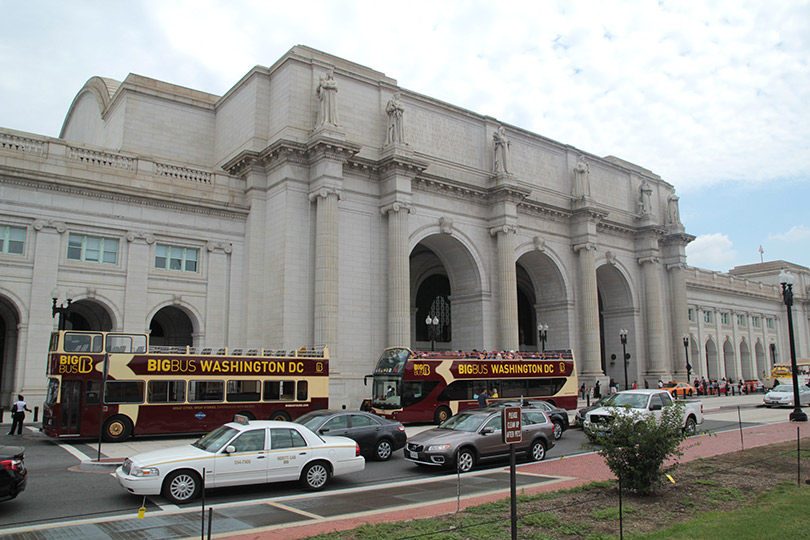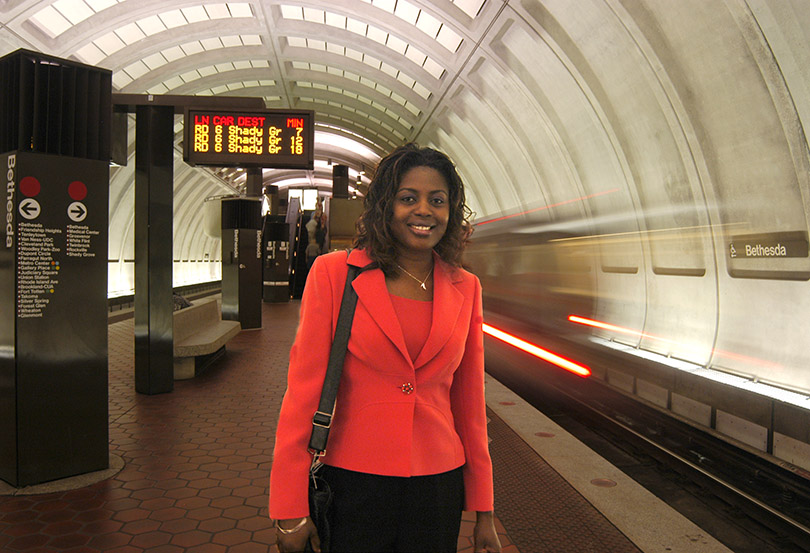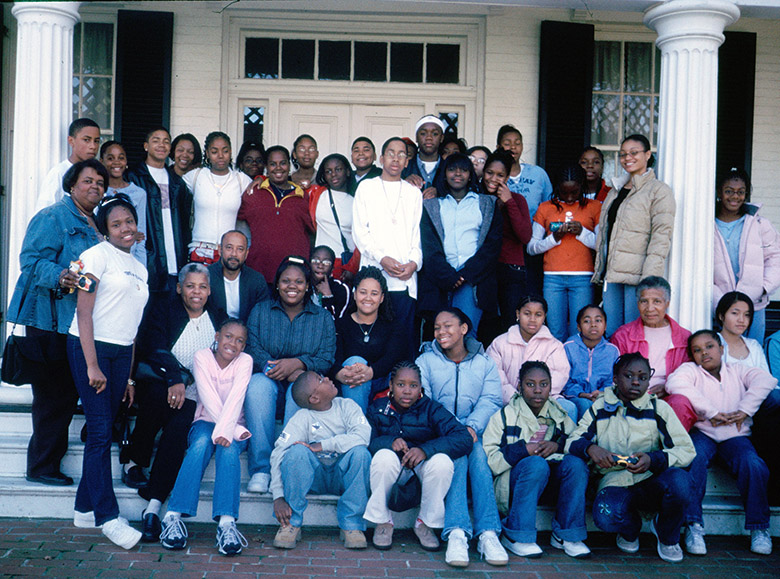
Dulles International Airport at night; credit Joe Ravi/Wiki Commons
Washington DC Transportation
Airports
Ronald Reagan National Airport (DCA) specializes in domestic flights to the eastern half of the country. That makes it the least busy commercial airport serving the region. Many locals still prefer it because DCA Airport has its own Metro Station. Taxis: Diamond and Yellow cabs at the ground transportation level are plentiful. Super Shuttle (800-258-3826) is also available for the short ride downtown.
Car Rentals: Alamo, Avis, Budget, Enterprise, Hertz, National, and Thrifty have 24-hour service at both airports. There is a confusing web of roads exiting the airport by rental car, so use caution and follow the EXIT TO WASHINGTON signs to get to the George Washington Parkway (I-395). If you are driving Downtown DC or the Federal District, watch for the fast-approaching 14th Street North exit off the parkway. If you miss that exit, there is another northbound exit shortly afterward. DCA Airport Terminal Map.
Dulles International Airport (IAD) specializes in long-distance domestic and international flights. It features a soaring architectural design whose terminal navigability finally matches its looks with the underground Automated People Mover.
You can now catch Metro Silver Line from Dulles Airport to several stations in Northern Virginia and to Metro Center Station and L’Enfant Station in DC. Or you can catch the Washington Flyer (703-685-1400) Shuttle from Dulles Airport to Washington Union Station.
Car Rentals: Alamo, Avis, Budget, Enterprise, Hertz, National, and Thrifty have 24-hour service at both airports.
Taxis: follow signs to taxi stands outside the terminal where a dispatcher will give you a rate sheet for estimated costs in downtown, Northern Virginia, and suburban Maryland. You can get a taxi outside of each terminal where a dispatcher is present at each taxi stand. Uber & Lyft also serve the airport. IAD Airport Terminal Map.

Wasshington Union Station, the hub of ground transportation in the region; (c) Soul Of America
Train Station
Washington Union Station, an architectural marvel, teems with upscale shops, restaurants, and a cineplex making it a huge tourist destination in its own right. This premier intermodal transportation center hosts DC Metrorail, MARC commuter rail, VRE commuter rail, Greyhound intercity buses, tour buses, shuttle buses, and car rentals.
Amtrak features these routes to/from Washington Union Station:
Acela: DC-Baltimore-Philadelphia-Newark-NYC-Stamford-New Haven-Providence-Boston
Northeast Regional1: DC-Baltimore-Wilmington-Philadelphia-Newark-NYC-Stamford-New Haven-Providence-Boston
Northeast Regional2: DC-Baltimore-Wilmington-Philadelphia-Newark-NYC-Stamford-New Haven-Hartford-Springfield
Crescent: NYC-Philadelphia-Baltimore-DC-Charlotte-Atlanta-New Orleans
Palmetto/Silver: NYC-Philadelphia-Baltimore-DC-Richmond-Jacksonville-Miami
Carolinian: NYC-Philadelphia-Baltimore-DC-Richmond-Raleigh-Charlotte
Cardinal: NYC-Philadelphia-Baltimore-DC-Cincinnati-Indianapolis-Chicago
Vermonter: St Albans-Burlington-NYC-Philadelphia-Baltimore-DC
A taxi depot is on the west side of Washington Union Station. To reduce Uber/Lyft wait time, arrange driver pick up at the Columbus Monument circle in front of Washington Union Station.
Amtrak Acela and Amtrak Northeast Regional trains run between New York City, Newark, Philadelphia, Baltimore, and Washington every 20-30 minutes. Other Amtrak trains go from NYC to Boston every 50-60 minutes. Coach class features comfortable seating with at least 39 inches of legroom, outlets for your laptop, complimentary WiFi, and extra storage space for luggage. Budget-minded travelers can take advantage of Amtrak Saver Fares and save when they book Coach seats 21 days or more in advance.
Northeast Regional Business class features even more extra legroom, extra Amtrak Guest Rewards Points an extra car dedicated to them, extra flexibility with an easily refundable ticket for those last-minute changes, reserved seating, and a complimentary beverage. Amtrak Crescent, Palmetto, Carolinian, Cardinal, Vermonter, and Capital Limited run once or twice daily.
In fall 2023, Nextgen Acela high-speed trains will run up to 160 mph in the Northeast Corridor on partially upgraded infrastructure and feature a better onboard experience. The same infrastructure will improve Amtrak Northeast Regional service too.
More infrastructure upgrades to the Northeast Corridor will unfold over 2026-35 that will increase train speed, frequency, and reliability. See Amtrak Acela progress towards world-class service.

Waiting for her train at Metro Bethesda Station; credit WMATA/Larry Levine
Rapid Transit
Metrorail transit system consists of 6-10 car trains in 6 lines serving 10 corridors in the city and suburbs. The lines average 33 mph and intersect at many stations over 117 miles of subway and aerial track, making it a reasonable alternative to get around without a car. “Metrorail” and “Metro” interchangeably name the system.
Visitors will appreciate that the Metrorail system features many architecturally distinct stations and that it goes to 80% of major visitor sites. The exceptions are Georgetown and National Harbor. Taxis/Uber/Lyft are common visitor options to/from Metro Stations.
Metro Blue & Yellow Lines go to Washington-Reagan National (DCA) Airport. Metro Silver Line goes to Dulles International Airport and beyond. See Metro System Map.
Metrorail fares depend on where you go. A premium is charged during Rush Hours. Purchase a one-day, weekend, or fixed dollar amount Farecard to avoid the fare scheme that feels cumbersome to visitors. Two children up to age 4 travel free with a paying customer. Metrorail has good station signage with useful system maps and is ADA-compliant, though elevators are sometimes difficult to locate. All stations feature bumpy tiles nearing the platform edge to alert sight-impaired patrons.
Metrorail operates Mon-Thu 5am-12am, Fri 5am-2pm, Sat 7am-1am, and Sun 7am-12am. Metrorail reduced train frequency to 8-15 minutes, depending on the line, and completed more maintenance work during the pandemic. Ridership is gradually returning to pre-pandemic levels.
DC Streetcar leave from Union Station along H Street/Benning Road corridor to Oklahoma Avenue.
Maryland Commuter Rail (MARC) features weekday trains that depart from Union Station to Baltimore every 30 minutes in evening commute and Virginia Railway Express (VRE) weekday commuter trains depart Union Station every 30-40 minutes during rush hours to Northern Virginia.
If you are traveling from Baltimore Metro Area, MARC commuter trains are a great option to avoid highway congestion to Metro Carrollton Station and Washington Union Station. If you are traveling from Northern Virginia I-95 Corridor, VRE commuter trains avoid highway congestion to Union Station as well. Metrorail, MARC, and VRE save you DC parking hassles.

Tour group visiting the Cedar Hill home of Frederick Douglass
Tours
Tour Washington DC
Specializing in Tours for Educational Groups, Family Reunions, Christian Faith Groups, and more of the nation’s capital. Amaze your convention, school, church, or civic group with an excellent and exciting tour of Washington. Their 4-Hour Tour includes Frederick Douglas House, African American Civil War Memorial, Howard University, and many other sites.
PHONE: 888-796-8763
WEBSITE: https://tourwashingtondc.com/
DC Circulator
Links cultural, entertainment, and business destinations within the city’s central core. This shuttle bus service is tailored for tourists leaving Washington Union Station to circulate among 3 routes every 10 minutes and costs far less than the Hop-On/Hop-Off tour option:
• Georgetown-K Street-Union Station
• Convention Center-Mall-SW Waterfront
• Smithsonian-National Gallery of Art
Near Union Station circulator buses depart from Louisiana Avenue. Georgetown and Convention Center buses run 7a-9p daily, Smithsonian buses run 10a-4p daily coincident with museum hours; fare is $1 per ride; seats up to 25 passengers on a mini-bus or van.
PHONE: 202-671-2020
WEBSITE: https://www.dccirculator.com
Freeways
Washington Freeway Network is very crowded during commute hours. Interstate 95 never runs through DC. Instead, it merges with I-495 on the eastern half of the Washington Beltway, then splits into its own freeway again in Maryland and Virginia. You can only enter/exit Dulles Airport Toll Road from Dulles Airport, I-495, and I-66 freeways.
Only I-395 Freeway takes you to Federal Center/Downtown. It has a northern spur to New York Avenue, which is good for reaching Howard University and U Street. Otherwise, DC freeways are an afterthought. Witness the clueless I-295 to I-395 intersection across the Anacostia River and lousy signage. Drivers on DC surface streets beware. Landscaped circles that bisect boulevards will confuse first-timers and slow traffic for all. Embassy limousine drivers sometimes run red lights and cause accidents with legal immunity.
If you drive to the Federal District, Foggy Bottom, Dupont Circle, U Street, Adams-Morgan, or Georgetown for dining or entertainment, use a parking garage to avoid the street meter running out. You DO NOT want a car tow or an expensive parking ticket.

We appreciate so much the fine work you have done here. We also appreciate very much the link to our site http://www.TourWashingtonDC.com
Our phone number is different now. We have a Toll-Free Number 888-796-8763
Would you mind changing that for us? We work with Groups, Family Reunions, Educational Groups and more.
Thank you again for this great information. We appreciate it so much.
You are now listed on SoulOfAmerica Washington Transportation Page. Please spread the love about SoulOfAmerica.com.